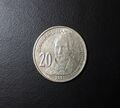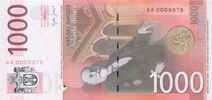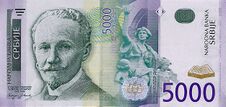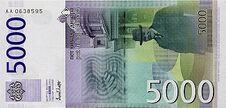Finance:Serbian dinar
| динар / dinar (Serbian) | |||||
|---|---|---|---|---|---|
| |||||
| ISO 4217 | |||||
| Code | RSD (numeric: 941) | ||||
| Subunit | 0.01 | ||||
| Unit | |||||
| Plural | динари / dinari ("dinars") | ||||
| Symbol | DIN / дин | ||||
| Denominations | |||||
| Subunit | |||||
| 1⁄100 | пара / para (defunct) | ||||
| Banknotes | |||||
| Freq. used | din. 10, din. 20, din. 50, din. 100, din. 200, din. 500, din. 1,000, din. 2,000[1] | ||||
| Rarely used | din. 5,000 | ||||
| Coins | |||||
| Freq. used | din. 1, din. 2, din. 5 | ||||
| Rarely used | din. 10, din. 20 | ||||
| Demographics | |||||
| Replaced | Yugoslav dinar | ||||
| User(s) | |||||
| Issuance | |||||
| Central bank | National Bank of Serbia | ||||
| Website | www | ||||
| Printer | Institute for Manufacturing Banknotes and Coins - Topčider | ||||
| Website | zin | ||||
| Mint | Institute for Manufacturing Banknotes and Coins - Topčider | ||||
| Website | zin | ||||
| Valuation | |||||
| Inflation | 8.0% (2023) | ||||
| Source | NBS | ||||
The dinar (Serbian Cyrillic: динар, pronounced [dînaːr]; paucal: dinara / динара; abbreviation: DIN (Latin) and дин (Cyrillic); code: RSD) is the currency of Serbia. The dinar was first used in Serbia in medieval times, its earliest use dating back to 1214. The dinar was reintroduced as the official Serbian currency by Prince Mihailo Obrenović in the 1868. One dinar was formerly subdivided into 100 para.
History
Medieval Serbian dinar
The first mention of a "Serbian dinar" dates back to the reign of Stefan Nemanjić in 1214. Until the fall of Despot Stjepan Tomašević in 1459, most of the Serbian rulers minted silver dinar coins. The first Serbian dinars, like many other south-European coins, replicated Venetian grosso, including characters in Latin (the word 'Dux' replaced with the word 'Rex').[7] It was one of the main export articles of medieval Serbia for many years, considering the relative abundance of silver coming from Serbian mines. Venetians were wary of this, and Dante Alighieri went so far as to put the Serbian king of his time, Stephen Uroš II Milutin of Serbia, in Hell as a forger (along with his Portuguese and Norwegian counterparts):[7]
| “ | E quel di Portogallo e di Norvegia lì si conosceranno, e quel di Rascia che male ha visto il conio di Vinegia. | ” |
First modern Serbian dinar (1868–1920)
Following the Ottoman conquest, different foreign currencies were used up to the mid-19th century. The Ottomans operated coin mints in Novo Brdo, Kučajna and Belgrade. The subdivision of the dinar, the para, is named after the Turkish silver coins of the same name (from the Persian پاره pāra, "money, coin"). After the Principality of Serbia was formally established (1817), there were many different foreign coins in circulation. Eventually, Prince Miloš Obrenović decided to introduce some order by establishing exchange rates based on the groat (Serbian groš, French and English piastre, Turkish kuruş) as money of account. In 1819 Prince Miloš Obrenović published a table rating 43 different foreign coins: 10 gold, 28 silver, and 5 copper.[8]
After the last Ottoman garrisons were withdrawn in 1867, Serbia was faced with multiple currencies in circulation. Thus, the prince Mihailo Obrenović ordered a national currency be minted. The first bronze coins were introduced in 1868, followed by silver in 1875 and gold in 1879. The first banknotes were issued in 1876. Between 1873 and 1894, the dinar was pegged at par to the French franc. The Kingdom of Serbia also joined the Latin Monetary Union.
In 1920, the Serbian dinar was replaced at par by the Yugoslav dinar, with the Yugoslav krone also circulating together.
Coins
In 1868, bronze coins were introduced in denominations of 1, 5, and 10 paras. The obverses featured the portrait of Prince Mihailo Obrenović III. Silver coins were introduced in 1875, in denominations of 50 paras, 1 and 2 dinars, followed by 5 dinars in 1879. The first gold coins were also issued in 1879, for 20 dinars, with 10 dinars introduced in 1882. The gold coins issued for the coronation of Milan I coronation in 1882 were popularly called milandor (French Milan d'Or). In 1883, cupro-nickel 5, 10, and 20 para coins were introduced, followed by bronze 2 para coins in 1904.
Banknotes
In 1876, state notes were introduced in denominations of 1, 5, 10, 50, and 100 dinars. The Chartered National Bank followed these notes from 1884, with notes for 10 dinars backed by silver and gold notes for 50 and 100 dinars. Gold notes for 20 dinars and silver notes for 100 dinars were introduced in 1905. During World War I, silver notes for 50 and 5 dinars were introduced in 1914 and 1916, respectively. In 1915, stamps were authorized for circulation as currency in denominations of 5, 10, 15, 20, 25, 30, and 50 paras.
Second modern Serbian dinar (1941–1944)
In 1941, the Yugoslav dinar was replaced, at par, by a second Serbian dinar for use in the German occupied Serbia. The dinar was pegged to the German reichsmark at a rate of 250 dinars = 1 reichsmark. This dinar circulated until 1944, when the Yugoslav dinar was reintroduced by the Yugoslav Partisans, replacing the Serbian dinar rate of 1 Yugoslav dinar = 20 Serbian dinars.
Coins
In 1942, zinc coins were introduced in denominations of 50 paras, 1 and 2 dinars, with 10 dinar coins following in 1943.
Banknotes
In May 1941, the Serbian National Bank introduced notes for 10, 20, 50, 100, 500, and 1,000 dinars. The 100 and 1,000 dinar notes were overprints, whilst the 10 dinar design was taken from an earlier Yugoslav note. Other notes were introduced in 1942 and 1943 without any new denominations being introduced.
Third modern Serbian dinar (2003–present)
The Serbian dinar replaced the Yugoslav dinar in 2003 when the Federal Republic of Yugoslavia was transformed into the State Union of Serbia and Montenegro. Both Montenegro and the disputed territory of Kosovo had already adopted the Deutsche Mark and later the euro when the mark was replaced by it in 2002. The Serbs in North Kosovo and the enclaves within it continue to use the dinar.[2][3][4][5][6]
Between 2003 and 2006, the Serbian dinar used the ISO 4217 code CSD, with CS being the ISO 3166-1 country code for Serbia and Montenegro. When the State Union was dissolved in 2006, the dinar's ISO 4217 code was changed to the current RSD.
Coins
Coins currently in circulation are din. 1, din. 2, din. 5, din. 10, and din. 20 coins. All coins feature identical inscriptions in Serbian, using the Cyrillic and Latin scripts. The din. 10 and din. 20 coins are uncommon in circulation, as banknotes of the same value are used instead.
- In 2011, the Serbian Coat of arms was slightly modified. In 2013 the metal content was slightly altered.[10]
| Coins[9] | |||||||||||||||||||||||||||||||||||||||||||||||||||||||||||||||||||||||||||||||||||||||||||||||||||||||||||||||||||||||||||||||||||||||||||||||||||||||||||||||||||||||||||||||
|---|---|---|---|---|---|---|---|---|---|---|---|---|---|---|---|---|---|---|---|---|---|---|---|---|---|---|---|---|---|---|---|---|---|---|---|---|---|---|---|---|---|---|---|---|---|---|---|---|---|---|---|---|---|---|---|---|---|---|---|---|---|---|---|---|---|---|---|---|---|---|---|---|---|---|---|---|---|---|---|---|---|---|---|---|---|---|---|---|---|---|---|---|---|---|---|---|---|---|---|---|---|---|---|---|---|---|---|---|---|---|---|---|---|---|---|---|---|---|---|---|---|---|---|---|---|---|---|---|---|---|---|---|---|---|---|---|---|---|---|---|---|---|---|---|---|---|---|---|---|---|---|---|---|---|---|---|---|---|---|---|---|---|---|---|---|---|---|---|---|---|---|---|---|---|---|
| Image | Value | Technical parameters | Description | Date of | |||||||||||||||||||||||||||||||||||||||||||||||||||||||||||||||||||||||||||||||||||||||||||||||||||||||||||||||||||||||||||||||||||||||||||||||||||||||||||||||||||||||||||
| Diameter | Mass | Composition | Edge | Obverse | Reverse | minting | issue | withdrawal | lapse | din. 1 | 20 mm | 4.34g | 70% Cu, 12% Ni, 18% Zn | reeded | Denomination, relief of the building of the National Bank of Serbia, year of minting | Issuer's symbols, logo of the National Bank of Serbia | 2003,2004 | 2 July 2003 | Current | din. 1 | 20 mm | 4.26g | 75% Cu, 0,5% Ni, 24,5% Zn | reeded | Coat of arms of Serbia, issuer's symbols | 2005-2009 | 2 July 2005 | din. 1* | 4.2g | Multilayer; low carbon steel core coated with a layer of copper on both sides/electroplated with a layer of copper and a layer of brass | 2009~present | 20 March 2009 | din. 2 | 22 mm | 5.24g | 70% Cu, 12% Ni, 18% Zn | reeded | Gračanica monastery | Issuer's symbols, logo of the National Bank of Serbia | 2003 | 2 July 2003 | din. 2 | 22 mm | 5.15g | 75% Cu, 0,5% Ni, 24,5% Zn | reeded | Coat of arms of Serbia, issuer's symbols | 2006~2010 | 27 December 2006 | din. 2* | 5.05g | Multilayer; low carbon steel core coated with a layer of copper on both sides/electroplated with a layer of copper and a layer of brass | 2009~present | 20 March 2009 | din. 5 | 24 mm | 6.23g | 70% Cu, 12% Ni, 18% Zn | reeded | Krušedol monastery | Issuer's symbols, logo of the National Bank of Serbia | 2003 | 2 July 2003 | din. 5 | 24 mm | 6.13g | 75% Cu, 0,5% Ni, 24,5% Zn | reeded | Coat of arms of Serbia, issuer's symbols | 2005~2012 | 2 July 2005 | |
|
din. 5* | 5.78g | Multilayer; low carbon steel core coated with a layer of copper on both sides/electroplated with a layer of copper and a layer of brass | 2013~present | 5 July 2013 | din. 10 | 26 mm | 7.77 g | 70% Cu, 12% Ni, 18% Zn | reeded | Studenica monastery | Logo of the National Bank of Serbia | 2003 | 2 July 2003 | current | din. 10 | Serbian coat of arms | 2005~present | 2 July 2005 | | | din. 10 | 26 mm | 7.77 g | reeded | 2009 Summer Universiade logo | Serbian coat of arms | 2009 | 26 June 2009 | | 
|
din. 20 | 28 mm | 9.00 g | reeded | Church of Saint Sava | Logo of the National Bank of Serbia | 2003 | 2 July 2003 | | 
|
din. 20 | 28 mm | 9.00 g | reeded | Portrait of Nikola Tesla | Serbian coat of arms | 2006 | 30 July 2006 | | 
|
din. 20 | 28 mm | 9.00 g | reeded | Portrait of Dositej Obradović, Serbian writer, philosopher, dramatist, librettist, translator, linguist, traveler, polyglot and the first minister of education of Serbia | Serbian coat of arms | 2007 | 10 December 2007 | | | din. 20 | 28 mm | 9.00 g | reeded | Portrait of Milutin Milanković | Serbian coat of arms | 2009 | 26 June 2009 | | | din. 20 | 28 mm | 9.00 g | reeded | Portrait of Đorđe Vajfert, industrialist, Governor of the National Bank of Serbia and Humanitarian | Serbian coat of arms | 2010 | 16 June 2010 | |
|
din. 20 | 28 mm | 9.00 g | reeded | Portrait of Ivo Andrić, Serbian nobel prize winner from modern day Bosnia | Serbian coat of arms | 2011 | 20 May 2011 | | | din. 20 | 28 mm | 9.00 g | reeded | Portrait of Mihajlo Pupin, Serbian physicist, physical chemist and philanthropist | Serbian coat of arms | 2012 | 8 June 2012 | ||||||||||||
Banknotes
In 2003, banknotes of the (re-established) National Bank of Serbia were introduced in denominations of din. 100, din. 1,000, and din. 5,000. din. 500 followed these in 2004, din. 50 in 2005, din. 10 and din. 20 in 2006, and din. 2,000 in 2011.
| Denomination | Obverse image | Reverse image | Main colour | Obverse | Reverse | Remark |
|---|---|---|---|---|---|---|
| din. 10 131 × 62 mm |

|

|
Ochre-yellow | Vuk Stefanović Karadžić (1787 – 1864), philologist and linguist | Member of the First Prague Slavic Congress, 1848 and a vignette of the letters Vuk introduced. | Replaced with a slightly lighter 2006 issue. A revised issue entered circulation in 2011. |
| din. 20 135 × 64 mm |

|

|
Green | Petar II Petrović-Njegoš (1813 – 1851), metropolitan, statesman, philosopher, and poet | His figure on the back, instead of the statue from the Mausoleum on Mount Lovćen. | Replaced with a slightly darker 2006 issue. A revised issue entered circulation in 2011. |
| din. 50 139 × 66 mm |

|

|
Violet | Stevan Stojanović Mokranjac (1856 – 1914), composer and music educator | Figure of Stevan Stojanović Mokranjac, a motif of Miroslav Gospels illumination scores. | Redesigned in 2005. A revised issue entered circulation in 2011. |
| din. 100 143 × 68 mm |

|

|
Blue | Nikola Tesla (1856 – 1943), inventor | A detail from the Tesla electro-magnetic induction engine. | Redesigned in 2003, 2004 and 2006. A revised issue entered circulation in 2012. |
| din. 200 147 × 70 mm |

|

|
Brown | Nadežda Petrović (1873 – 1915), painter | Silhouette of the Gračanica Monastery. | Redesigned in 2005. A revised issue entered circulation in 2011. |
| din. 500 147 × 70 mm |

|

|
Cyan | Jovan Cvijić (1865 – 1927), geographer | Stylized ethnic motifs. | Redesigned in 2007. A revised issue entered circulation in 2011. |
| din. 1,000 151 × 72 mm |

|

|
Red | Đorđe Vajfert (1850 – 1937), industrialist | An outline of Weifert's beer brewery, hologram image of St. George slaying a dragon; details from the interior of the main building of the National Bank of Serbia. | Redesigned in 2003 and 2006. A revised issue entered circulation in 2011. |
| din. 2,000 155 × 74 mm |

|

|
Grey | Milutin Milanković (1879 – 1958), mathematician, astronomer and geophysicist | Milanković's figures while at the desk (below: a graphical representation of his calculations of snow boundary movement for the past Quaternary) and from his student days in Vienna (behind: a stylised Sun disk drawing fragment and an illustration of Milanković's work). | Entered circulation in 2011.[1] |
| din. 5,000 159 × 76 mm |

|

|
Purple | Slobodan Jovanović (1869 – 1958), jurist, historian and politician | Stylized representation of the interior of the assembly hall; silhouette of the National Assembly. | Redesigned in 2010. A revised issue entered circulation in 2016.[11] |
See also
- Economy of Serbia
- Yugoslav dinar
- Yugoslav krone
Notes
References
- ↑ 1.0 1.1 New 2000 dinars and revised 1000 and 500 dinars banknotes in circulation, National Bank of Serbia.
- ↑ 2.0 2.1 Mitchell, Lawrence: Travel Guide Serbia, p. 324-325.
- ↑ 3.0 3.1 "Kosovo's bitter enemies look to heal old wounds". 28 April 2018. https://www.theguardian.com/world/2018/apr/28/kosovo-serbia-ethnic-divide.
- ↑ 4.0 4.1 "Points of dispute between Kosovo and Serbia". 9 November 2018. https://www.france24.com/en/20181109-points-dispute-between-kosovo-serbia.
- ↑ 5.0 5.1 "Kosovo loses millions of euros from the use of the Serbian dinar". Kosova Press. 12 September 2020. https://kosovapress.com/en/kosovo-loses-millions-of-euros-from-the-use-of-the-serbian-dinar/.
- ↑ 6.0 6.1 "Foreign travel advice Kosovo". UK Government. https://www.gov.uk/foreign-travel-advice/kosovo/money.
- ↑ 7.0 7.1 Dejan Djokić (2023). A Concise History of Serbia. Cambridge University Press. pp. 108. ISBN 978-1-107-02838-8.
- ↑ Wieser, F. (1965). Contributions to the monetary history of Serbia, Montenegro and Yugoslavia. London: Spink & Son, Ltd. p. 3.
- ↑ National Bank of Serbia. Available at:http://www.nbs.rs/internet/english/75/index.html
- ↑ National Bank of Serbia. Available at:http://www.nbs.rs/internet/english/75/75_1/k-1.html
- ↑ Serbia new 5,000 dinar note confirmed BanknoteNews.com. Retrieved 2011-12-23
Sources
External links
- Heiko Otto, ed. "Historical and current banknotes of Serbia" (in en,de). http://www.bis-ans-ende-der-welt.net/Serbien-B-En.htm.
 |





